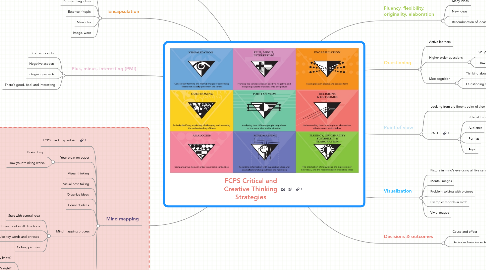FCPS Critical and Creative Thinking Strategies
Toni Krasnicにより


1. Encapsulation
1.1. Most important
1.2. Representing ideas
1.3. Essence if topic
1.4. Main idea
1.5. Image, word
2. Mind mapping
2.1. FCPS mind map rubric
2.2. Your brain on paper
2.2.1. Brain dump
2.2.2. How your thinking works
2.3. Visual thinking
2.4. Visual note taking
2.5. Organize ideas
2.6. Connect ideas
2.7. Mind mapping process
2.7.1. Start with central idea
2.7.2. Branch out in all directions
2.7.3. Use key words and phrases
2.7.4. Colors, pictures
2.8. Common uses
2.8.1. Pre-assessment
2.8.1.1. What do students already know?
2.8.1.2. What's right?
2.8.1.3. What's wrong?
2.8.1.4. What's missing?
2.8.2. Post-asssessment
3. Plus, minus, interesting (PMI)
3.1. Positive aspects
3.2. Negative aspects
3.3. Intriguing aspects
3.4. There's good, bad, and interesting
4. Visualization
4.1. Picture in mind's eye using all five senses
4.2. Mental images
4.3. Problem solving with pictures
4.4. Example: models in math
4.5. Vivid images
5. Analogies
5.1. Comparing ideas/things to see similarities
6. Decisions & outcomes
6.1. Cause and effect
6.2. Decisions have impacts on outcomes
7. Questioning
7.1. Active learners
7.2. Higher order questions
7.2.1. Why?
7.2.2. How?
7.3. Metacognition
7.3.1. Thinking about thinking
7.3.2. Questioning our thinking process
8. Point of view
8.1. Looking from a different point of view
8.2. RAFT
8.2.1. Role of the writer
8.2.2. Audience
8.2.3. Format
8.2.4. Topic
